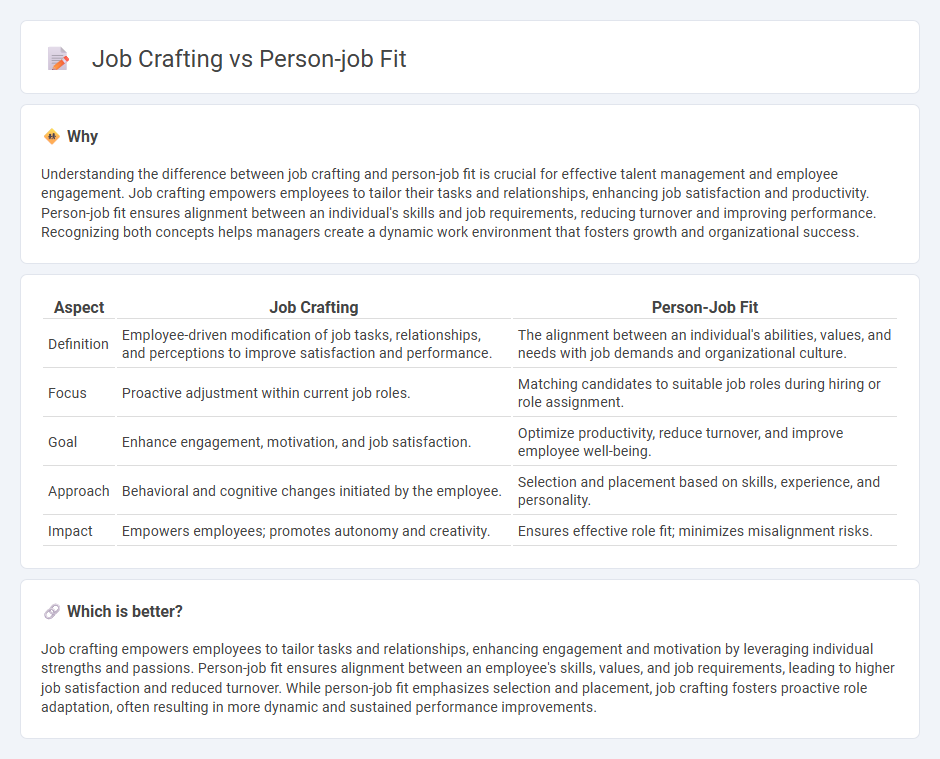
Job crafting empowers employees to actively redesign their tasks, relationships, and perceptions at work, enhancing engagement and satisfaction. In contrast, person-job fit focuses on aligning individual skills and characteristics with job requirements to optimize performance and reduce turnover. Explore these strategies to improve workplace effectiveness and employee well-being.
Why it is important
Understanding the difference between job crafting and person-job fit is crucial for effective talent management and employee engagement. Job crafting empowers employees to tailor their tasks and relationships, enhancing job satisfaction and productivity. Person-job fit ensures alignment between an individual's skills and job requirements, reducing turnover and improving performance. Recognizing both concepts helps managers create a dynamic work environment that fosters growth and organizational success.
Comparison Table
| Aspect | Job Crafting | Person-Job Fit |
|---|---|---|
| Definition | Employee-driven modification of job tasks, relationships, and perceptions to improve satisfaction and performance. | The alignment between an individual's abilities, values, and needs with job demands and organizational culture. |
| Focus | Proactive adjustment within current job roles. | Matching candidates to suitable job roles during hiring or role assignment. |
| Goal | Enhance engagement, motivation, and job satisfaction. | Optimize productivity, reduce turnover, and improve employee well-being. |
| Approach | Behavioral and cognitive changes initiated by the employee. | Selection and placement based on skills, experience, and personality. |
| Impact | Empowers employees; promotes autonomy and creativity. | Ensures effective role fit; minimizes misalignment risks. |
Which is better?
Job crafting empowers employees to tailor tasks and relationships, enhancing engagement and motivation by leveraging individual strengths and passions. Person-job fit ensures alignment between an employee's skills, values, and job requirements, leading to higher job satisfaction and reduced turnover. While person-job fit emphasizes selection and placement, job crafting fosters proactive role adaptation, often resulting in more dynamic and sustained performance improvements.
Connection
Job crafting enhances person-job fit by allowing employees to reshape tasks and relationships to better align with their skills and motivations, leading to increased job satisfaction and performance. Through proactive adjustments, workers create a more personalized role that meets both individual needs and organizational demands. This dynamic interaction between job crafting and person-job fit fosters greater engagement and reduces turnover rates.
Key Terms
Alignment
Person-job fit emphasizes aligning individual skills, abilities, and interests with job requirements to enhance performance and job satisfaction. Job crafting involves employees proactively modifying their tasks, relationships, and perceptions to better align the job with their strengths and motivations. Explore how improving alignment through both person-job fit and job crafting can optimize employee engagement and organizational success.
Customization
Person-job fit emphasizes aligning an individual's skills, abilities, and preferences with a job's requirements to enhance performance and satisfaction, while job crafting involves employees proactively modifying their tasks, relationships, or perceptions to better suit their strengths and interests. Customization in person-job fit is typically organization-driven, focusing on recruitment and placement strategies, whereas job crafting originates from the employee, fostering personalized adjustments that improve engagement and motivation. Explore how integrating person-job fit and job crafting strategies can optimize workforce customization and drive organizational success.
Engagement
Person-job fit emphasizes aligning an individual's skills, abilities, and interests with specific job requirements to boost work engagement and satisfaction. Job crafting involves employees proactively modifying their job tasks, relationships, or perceptions to enhance meaningfulness and personal engagement. Explore how combining person-job fit and job crafting strategies can significantly improve employee engagement and productivity.
Source and External Links
Personality-job fit theory - This theory posits that an individual's personality traits can reveal their adaptability within an organization, impacting job satisfaction and performance.
Person-Job Fit: A match made in hiring - This concept focuses on the compatibility between an individual and their job, enhancing job satisfaction, well-being, and organizational commitment when aligned.
What is Job Fit and Why Does It Matter? - This assessment evaluates how closely a candidate's values, personality, and characteristics match the tasks and requirements of a job, impacting job fit and organizational success.
 dowidth.com
dowidth.com